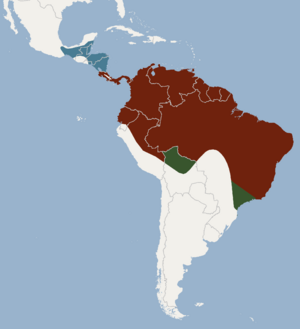Fringe-lipped bat facts for kids
The fringe-lipped bat (Trachops cirrhosus) is a special type of leaf-nosed bat. You can find it in places from southern Mexico all the way down to Bolivia and southern Brazil. It's the only species in its group, which is called a genus. This bat has three different kinds, or subspecies.
Quick facts for kids Fringe-lipped bat |
|
|---|---|
| Conservation status | |
| Scientific classification | |
| Genus: |
Trachops
|
| Species: |
cirrhosus
|
 |
|
| Distribution of the fringe-lipped bat | |
Contents
What Does the Fringe-lipped Bat Look Like?
The fringe-lipped bat gets its name from the small, wart-like bumps on its lips and nose area. Its fur is long and feels woolly. The bat is mostly reddish-brown, with a gray color on its belly. It's a medium-sized bat, usually weighing around 32 grams.
This bat has a short tail. It also has a special nose-leaf with jagged edges. Inside its mouth, it has two pairs of lower front teeth. It also has three pairs of lower premolars, which are grinding teeth. The molars, or back teeth, have W-shaped bumps. The front part of its skull is shorter than the braincase. However, it is about the same width as the braincase. This bat has wings that are wide and short. This shape helps it fly well in tight spaces.
How Do Fringe-lipped Bats Reproduce?
Fringe-lipped bats usually mate during the dry season. This season is typically from January to June in tropical areas. It's hard to tell the difference between male and female bats just by looking at them. The female bat gives birth to only one baby at a time. The young bats can stay with their parents for a long time after they are born.
Where Do They Live and What Do They Eat?
Fringe-lipped bats like to live near ponds or streams. They make their homes, called roosts, in trees or hollow logs. Sometimes, they even roost in caves. They prefer tropical forests, both dry and moist ones.
The Trachops cirrhosus is an omnivore, meaning it eats both plants and animals. It mostly eats insects. But it also enjoys lizards, frogs (like the Hyalinobatrachium fleischmanni), fruits, and seeds. In very rare cases, these bats have even been seen eating other bats, such as the Furipterus horrens. Sometimes, they share their roosts with other kinds of bats. Gray four-eyed opossums sometimes hunt and eat these bats.
How Do Fringe-lipped Bats Behave?
Fringe-lipped bats live in groups of up to 50 bats. Both male and female bats roost together. They leave their roosts early, often when it's still daylight. This is the best time for them to hunt frogs. They hunt by flying continuously or by swooping down from a perch.
These bats find their food by listening for sounds from insects and frogs. They also use echolocation. Echolocation is like sending out sound waves and listening for the echoes to create a picture of their surroundings. Some frog species, like the Smilisca sila, have learned ways to confuse bats. They do this by calling out at the same time, making it harder for the bats to find them.
Are Fringe-lipped Bats Safe?
The fringe-lipped bat is currently listed as "least concern" for its conservation status. This means their populations are stable right now. Because of this, there are no special plans to protect them. However, because of what they eat, they could be at risk from human activities.
Gallery




